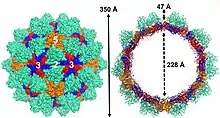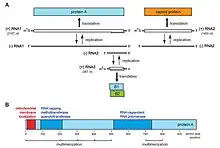| Nodaviridae | |
|---|---|
 | |
| Crystal structure of grouper nervous necrosis virus a piscine betanodavirus | |
| Virus classification | |
| (unranked): | Virus |
| Realm: | Riboviria |
| Kingdom: | Orthornavirae |
| Phylum: | Kitrinoviricota |
| Class: | Magsaviricetes |
| Order: | Nodamuvirales |
| Family: | Nodaviridae |
Nodaviridae is a family of nonenveloped positive-strand RNA viruses.[1] Vertebrates and invertebrates serve as natural hosts. Diseases associated with this family include: viral encephalopathy and retinopathy in fish. There are nine species in the family, assigned to two genera.[2][3]
History
The name of the family is derived from the Japanese village of Nodamura, Iwate Prefecture where Nodamura virus was first isolated from Culex tritaeniorhynchus mosquitoes.
Virology
Structure
The virus is not enveloped and has an icosahedral capsid (triangulation number = 3) ranging from 29 to 35 nm in diameter. The capsid is constructed of 32 capsomers.[2]
Genome

The genome is linear, positive sense, bipartite (composed of two segments – RNA1 and RNA2) single stranded RNA consisting of 4500 nucleotides with a 5’ terminal methylated cap and a non-polyadenylated 3’ terminal.[2]
RNA1, which is ~3.1 kilobases in length, encodes a protein that has multiple functional domains: a mitochondrial targeting domain, a transmembrane domain, an RNA-dependent RNA polymerase (RdRp) domain, a self-interaction domain and an RNA capping domain. In addition, RNA1 encodes a subgenomic RNA3 that encodes protein B2, an RNA silencing inhibitor.[2]
RNA2 encodes protein α, a viral capsid protein precursor, which is auto-cleaved into two mature proteins, a 38 kDa β protein and a 5 kDa γ protein, at a conserved Asn/Ala site during virus assembly.[2]
Life cycle
Viral replication is cytoplasmic. Entry into the host cell is achieved by penetration into the host cell. Replication follows the positive stranded RNA virus replication model. Positive stranded RNA virus transcription, using the internal initiation model of subgenomic RNA transcription is the method of transcription. Vertebrates and invertebrates serve as the natural host. Transmission routes are contact and contamination.[2][3]
Taxonomy
The members of the genus Alphanodavirus were originally isolated from insects while those of the genus Betanodavirus were isolated from fish. A small number of nodoviruses seem to lie outside either of these clades.[2] Flock house virus (FHV) is the best studied of the nodaviruses.[2] There are nine species in this family, assigned to two genera:[2]
- Alphanodavirus
- Black beetle virus
- Boolarra virus
- Flock House virus
- Nodamura virus
- Pariacoto virus
- Betanodavirus
- Barfin flounder nervous necrosis virus
- Redspotted grouper nervous necrosis virus
- Striped jack nervous necrosis virus
- Tiger puffer nervous necrosis virus
References
- ↑ Sahul Hameed, AS; Ninawe, AS; Nakai, T; Chi, SC; Johnson, KL; ICTV Report, Consortium (January 2019). "ICTV Virus Taxonomy Profile: Nodaviridae" (PDF). The Journal of General Virology. 100 (1): 3–4. doi:10.1099/jgv.0.001170. PMID 30431412.
- 1 2 3 4 5 6 7 8 9 "ICTV Report Nodaviridae".
- 1 2 "Viral Zone". ExPASy. Retrieved 15 June 2015.